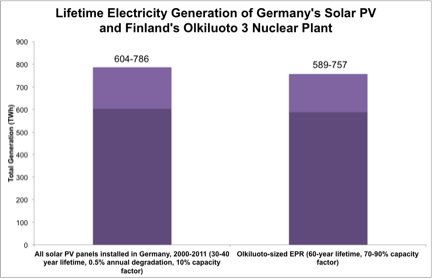Cost of German Solar Is Four Times Finnish Nuclear
Olkiluoto Nuclear Plant, Plagued by Budget Overruns, Still Beats Germany’s Energiewende
-
-
Share
-
Share via Twitter -
Share via Facebook -
Share via Email
-
Germany’s solar program will generate electricity at quadruple the cost of one of the most expensive nuclear power plants in the world, according to a new Breakthrough Institute analysis, raising serious questions about a renewable energy strategy widely heralded as a global model.
The findings challenge the idea that solar photovoltaic is a disruptive, scalable, “shelf-ready” technology with a cost advantage over nuclear. Energy analysts frequently point to Finland’s advanced nuclear project at Olkiluoto, which is seven years behind schedule and billions of dollars over budget, and solar in Germany as indicative of future cost trends working against new nuclear technologies and in favor of solar.
Proponents of Germany’s Energiewende, which now involves jettisoning the country’s nuclear fleet by 2023, argue that solar and wind can make up the difference in lost capacity. A straightforward cost comparison between the two programs over the same 20-year period, however, reveals the costs of this proposition.
The Finnish European pressurized reactor (EPR), with an estimated total cost of $15 billion, will generate over half as much energy as the entire existing German solar program, which will run to roughly $130 billion. The total cost of electricity produced by German solar will be 32 cents per kilowatt-hour versus 7 cents per kilowatt-hour for the Areva-Siemens nuclear plant in Finland — a more than four-fold difference. Two such nuclear plants would generate slightly more than Germany’s solar panels, at less than a fourth the total cost.
The $15 billion estimate for Finland’s Olkiluoto 3 reactor is based on fixed1 and variable costs ($0.02/kWh).2 The reactor will generate about 225 TWh in a 20-year timeframe,3 more than half of what all of Germany’s solar panels installed between 2000 and 2011 will generate over their 20-year feed-in tariff contracts.
The construction of Unit 3 of Finland’s Olkiluoto nuclear power plant — approved by the Finnish government in 2005 and built by a consortium involving the French company Areva and Germany’s Siemens — has come under fire for construction delays and cost overruns. The 1,600-megawatt project, which aims to meet 10 percent of Finland’s energy demand, is being built on an island in the Baltic Sea.
Initially expected to cost $4.2 billion and take four years to complete, Unit 3 is now estimated to cost at least $11.1 billion and will not enter into service before 2016.4 Olkiluoto 3 is the first of four advanced European Pressurized Reactors (EPRs), with others under construction in France and China. Finland’s project has been criticized as an example of “all that can go wrong in economic terms with new reactors.”5
German solar panels installed between 2000 and 2011 will cumulatively supply about 400 terawatt-hours (TWh) to the grid by 2031. Between 2000 and 2031 Germany’s electricity ratepayers will pay about $130 billion for the solar PV generation from these panels installed between 2000 and 2011 in the form of 20-year feed-in tariff contracts,6 at an average cost of 32 cents a kWh.
Moreover, solar panels do not last as long as nuclear reactors and also give reduced output as they age. After three decades a single nuclear plant with the same output of Olkiluoto would generate about as much electricity as all of the German panels installed in the last decade.7 Over its entire 60-year lifetime, the EPR will generate between 589-757 TWh, depending on capacity factor.8
Assuming a 0.5 percent degradation rate for solar PV cells (a widely used figure), the 24.7 GW of solar PV capacity installed in Germany will generate 786 TWh over 40 years, or 604 TWh over 30 years (solar PV lifetimes are commonly considered in the 25-30 year range),9 just a slightly higher output range than that of a single EPR. After a 30 to 40 year period some panels may continue to generate electricity but most will be taken offline or replaced, and owners will incur new capital and installation costs.
Over its entire 60-year lifetime the EPR will provide electricity at a rate of 3.5-3.9 cents per kWh, compared to 16.5-21.5 cents per kWh for solar panels over their 30-40 year lifetimes.10
FURTHER READING
"Cost of German Solar Is Four Times Finnish Nuclear"
"Frequently Asked Questions About Nuclear Power"
"Planetary Emergency? Then Go Nuclear"
1. We adopted Areva’s most recent capital cost estimate, $11.1 billion. See http://m.foxbusiness.com/quickPage.html?page=19453&content=85055560&pageNum=-1.
2. The US Nuclear Energy Institute estimates that variable production costs for the US nuclear fleet averaged 2.1 cents per kWh between 2003 and 2011. EIA Estimates that the variable costs of new advanced nuclear are about 1.2 cents/kWh. See http://www.eia.gov/forecasts/aeo/electricity_generation.cfm.
3. Assumes that the reactor will run at 80 percent of its total 1600-megawatt capacity over the 20-year period. In the United States the entire nuclear fleet has been running at >80 percent of its capacity since the late 1990s.
4. See http://www.world-nuclear-news.org/NN-Olkiluoto_3_delayed_beyond_2014-1707124.html.
5. See http://www.psr.org/safe-energy/the-myth-of-the-european.html.
6. Frondel, M., Schmidt, C. M., and C. Vance, “Germany’s Solar Cell Promotion: An Unfolding Disaster,” (Ruhr Economic Papers, July 2012). See Figure 5: Annual Feed-in Tariffs for PV and Table 3: Net Costs of Promoting PV in Germany on pages 10 and 12, respectively.
7. The study that we draw on to estimate the cost of Germany’s nuclear program by Frondel et al. (2012) does not include a degradation rate in their analysis, which is why we’ve included one here but not in the other calculations.
8. For simplification we chose not to include a range of nuclear capacity factors in the previous calculations.
9. Actual solar PV panel lifetime is not well known because most panels have not been operating for more than a decade or two. But the studies that have focused on older panels have found a lifetime range of 25-30 years. For instance, see Artur Skoczek, Tony Sample, Ewan D. Dunlop, “The Results of Performance Measurements of Field-aged Crystalline Silicon Photovoltaic Modules,” Progress in Photovoltaics: Research and Applications, 17:227-240 (2009).
10. Note that in this calculation we do not include unexpected capital costs that might be incurred over the lifetimes of the nuclear plant and solar panels.












